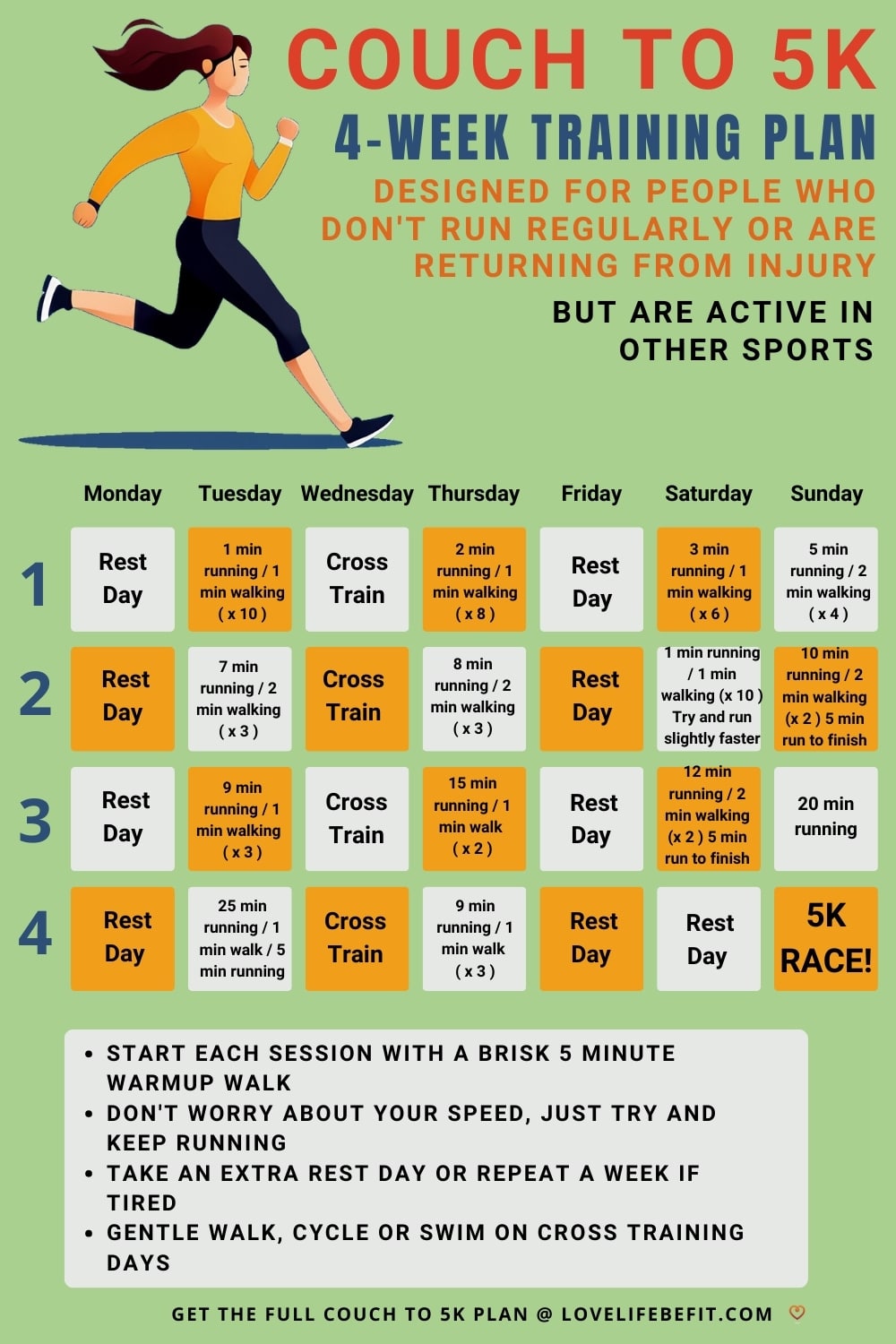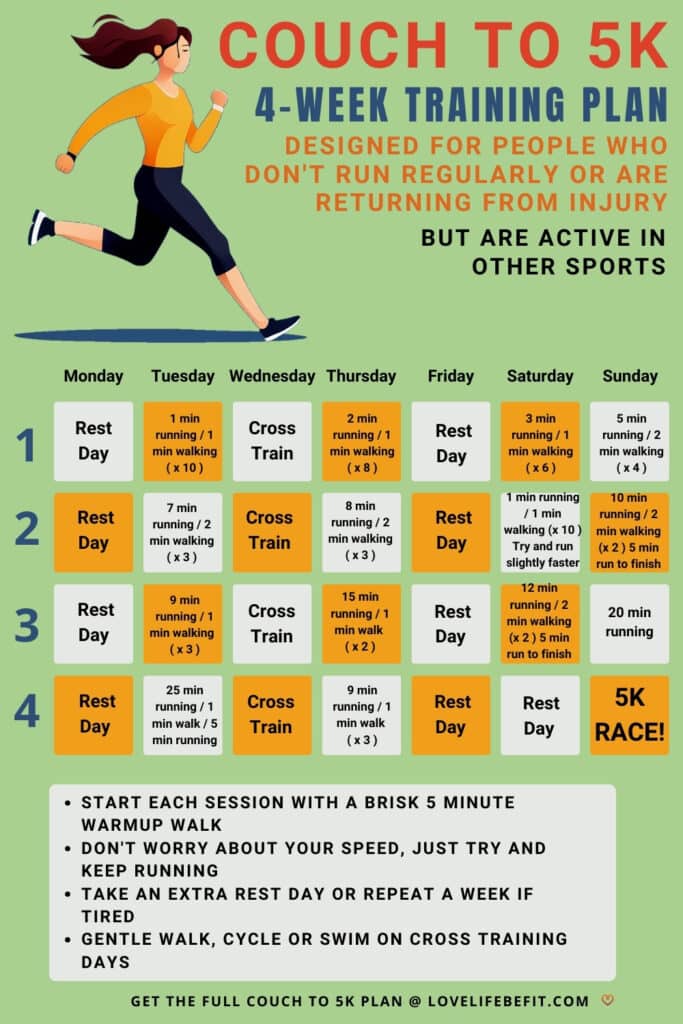4 Week 5K Training Plan For Beginners + Complete Guide
This 4 week 5K training plan is for beginner runners. You could use it as a Couch To 5K plan, but if you’re non-active and not used to running at all, you’ll probably end up walking most of the way around the 5K route.
Instead, it’s a plan for someone who runs occasionally and wants to get in shape for a 5K race, for beginner runners who are fit from other sports, and for any runner returning from injury.
Like Couch to 5K, this plan starts with gentle run/walk intervals to ease you back into running. But this plan rapidly ramps up the running distance to get you ready for race day.
The free training plan is ready for download at the end of the post but read on for tips to get the most out of your training.

Our 4 Week Beginner 5K Training Plan
A structured training plan will help you get the best results from your running. This plan will help you get over the finish line on race day. If you haven’t entered a race yet, find a local park run. Park runs are weekly 5K races and they’re free to enter!

How Far Is 5K?
The “K” can be confusing if you’re not used to the metric system. It stands for the metric unit of a kilometer. 5K represents 5000 meters.
If you’re more used to miles, 5K in miles is 3.1 miles.
Can You Train For 5K In 4 Weeks?
Training for a 5K in 4 weeks depends on your starting fitness level. If you’re young or have residual fitness from other sports it should be possible.
Likewise, if you already run occasionally, you should find this training plan straightforward. You may even find the first week of training a little easy.
If you’re completely new to running and non-active, it’s better to follow one of our Couch to 5K plans such as the 6-week 5K training plan or the Couch To 5K in 9-week plan.
But if you only have 4 weeks to train and you haven’t laced up a pair of running shoes in years, you can still use this 5K training program. Just be prepared to take extra walking breaks and rest days if you get tired and sore.
A word about feeling sore
If the soreness eases off during your warm-up it’s normally okay to continue training. Otherwise, take an extra rest day.
Actual pain is a red flag. Get any persistent niggles or painful areas checked out straightaway by a physiotherapist.
If the training plan gets too hard, repeat a week or switch to a longer program. Doing more than your body can cope with will just leave you feeling demotivated.
We want you to become a lifelong runner and not be put off by following the wrong training plan. As a beginner runner, it’s important to start training at a level within your comfort zone. The training will push you at times but it should still feel manageable.

Who Is This Training Plan For?
This 4-week 5K training schedule is for occasional runners or people with some fitness from other sports. It’s also a good plan to use if you’re returning from injury.
How To Use The 5K Training Program

This plan will get you to the starting line in the best possible shape. Four weeks isn’t very long so don’t expect miracles.
The aim is to complete the distance running continuously. This isn’t a plan for advanced runners. If you are able to complete the sessions as intended – running when you’re supposed to run, you should make it around the 5K without walking breaks.
This isn’t a training plan for speed. It’s better for beginner runners to build up a good running base and build a regular running habit before trying to run faster.
Time-based workouts
The sessions are based on running time instead of distance to make sure slower runners aren’t working harder than naturally faster runners. Running should be at a conversational pace.
Ideally, you’ll be able to talk and run without getting out of breath. This might be a big ask for new runners, but if you’re struggling to breathe, slow down. Find out more about how to breathe while running.
The first session starts with very short 1-minute running/walking intervals. The running distances quickly become longer so that you’re running for 5 minutes continuously by the end of the first week.
If you’re already used to running, replace the run/walk intervals with short 5 to 10-minute runs.
Running Distance
The longest sessions in the 4 week 5K training plan are about 30 minutes of running. Beginners can expect to take 30 to 40 minutes to run 5K.
You may not run as far as 5K during your longer training runs but on race day, adrenaline will get you to the finish line!
Aim to be running consistently. Your running speed isn’t important. Instead, try and run at a pace you can maintain for the length of the training session.
Cross Training
The training plan includes one cross-training session per week. You can cross-train by walking, cycling, swimming… just about any activity that keeps you active for about 30 minutes. Find out more about cross-training for runners.
Strength Training
Working on your leg and core strength helps runners avoid injury. We suggest you add two short 10 to 15 minutes of strength training to your plan during the first 3 weeks.
Complete the strength training sessions after your shorter runs or cross-training. These bodyweight exercises for runners are ideal.
Rest Days
The plan includes 2 rest days per week – don’t skip them! These rest days give your muscles, tendons, and joints are chance to recover for your next sessions.

More Training Tips
#1 Running shoes
Comfortable running shoes can make all the difference and help you avoid the injuries that sometimes plague new runners.
The best advice is to visit an independent running store. You don’t need top-of-the-range running shoes but you do need to make sure your shoes fit correctly and are appropriate for your running style.
#2 Avoid Over-Striding
As you become an experienced runner, your running efficiency will improve but there are a few things you can try right now for better performance and to avoid running injuries.
- Run tall and look ahead. Keep upright and avoid bending over at the waist. Don’t look at your feet – instead, keep your eyes focused 10 to 20 feet ahead.
- Use your arms. Find a natural arm swing with your arms bent at about 90 degrees.
- Keep your cadence up. Cadence is your step rate. When you start to tire during your runs keep your cadence up.
- Land with your feet under your body. Heel striking isn’t always bad news but you do want to land with your feet under your body. If your stride length is too long, you’ll slam your heels into the pavement.
Find out more about running form.
#3 Don’t Run Through Pain
Some discomfort can be expected. A little stiffness, achy legs, a bit sore – take an extra day off if you need to.
Pain is different. If you feel any sharp pain during your runs or soreness that doesn’t abate, abandon your training and seek the advice of a professional.
Race Day Tips
These tips are specific to race day and getting you across the finish line.
#1 Don’t try anything new
A race isn’t the time to try anything new. Wear the clothing and footwear you used in training.
#2 Don’t eat too much
5K is a relatively short race. It can feel fast and the last thing you want is to be regurgitating the heavy meal you had the night before. You don’t need to carbo load for a 5k race – keep your meal light.
Similarly, you don’t want to eat too much before the race. If the race is in the morning, get up early and eat a light breakfast at least 1-2 hours before your race.
Keep it small – a piece of toast with nut butter, or just a banana is often all you need. Stick to the food you’re used to eating. This is no time for experimenting.
#3 Make sure you’re hydrated
Drink enough before the race to make sure you’re fully hydrated but don’t overdo it. It’s best to drink to thirst.
#4 Don’t set off too fast
There will be much faster runners than you at the race. So don’t get carried away. Try and keep to a pace you can maintain over the whole distance.
#5 Walking break
If you need to take walking breaks that’s perfectly fine. As soon as you get your breath back start running again!
#6 Enjoy your race!
It’s okay to enjoy your race. You’ve put in the training and you should be proud of yourself. Enjoy the atmosphere and celebrate finishing!
Advice From Love Life Be Fit
Make sure you choose a training plan that’s suitable for your current fitness level. If it’s a long time since you last exercised, give yourself some more time to train or accept that you’ll need to take walking breaks during your 5K race.
When you’ve completed your first 5K – celebrate! And then set your next goal! It could be running a 10K with our 5K To 10K Training Plan or stepping up to run a half marathon.
Running 101 Training Guides & Walking Schedules
5K Training Plans
- Couch To 5K Beginner Training Plan
- 12 Week 5K Training Plan
- 10 Week 5K Training Plan
- 8 Week 5K Training Plan
- 6 Week 5K Training Plan
- 4 Week 5K Training Plan
- 5K Training Plan Intermediate







